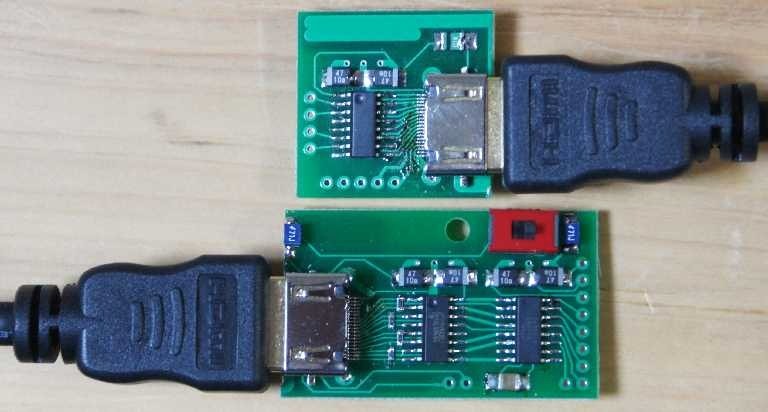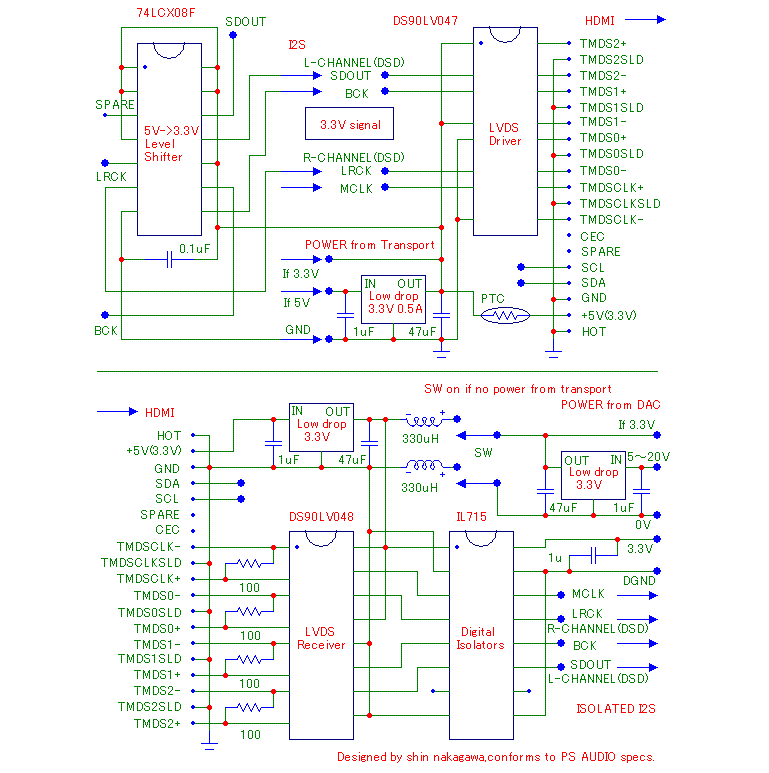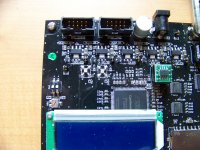NDK oscillator
Just to confirm what others have said here, the NDK oscillators are an audibly positive upgrade for the SD Trans.
This player seems to respond well to improved power supplys. I am going through my shunt/super reg stashes and listening.
I would be very interested to know what RayCtech is using.
Just to confirm what others have said here, the NDK oscillators are an audibly positive upgrade for the SD Trans.
This player seems to respond well to improved power supplys. I am going through my shunt/super reg stashes and listening.
I would be very interested to know what RayCtech is using.
Attachments
This player seems to respond well to improved power supplys. I am going through my shunt/super reg stashes and listening.
I would be very interested to know what RayCtech is using.
Today, I listened to a power supply updated version of Rev. 2.1 by RayCTech. The SDTrans192 has NDK oscillators already. DAC connected are Twisted Pear Audio Buffalo II with IVY III and Wolfson 8741 Evaluation Board.
The effect of JFET voltage regulators with audio grade caps designed and implemented by RayCTech is excellent. The best sounds I have ever heard though my experiences are limited. Very pure and clear.
I feel every tone in usual CD sources (44.1 kHz / 16 bit PCM WAV files) has its hyperfine structure or well focused.
Quality of bass is also superior.
I want to listened to all the CD sources I have with this player again.
I wish any user of SDTrans192 is able to share this upgrade.
Interesting info!
How many regulators did you use for the SDTrans192, and what were they supplying?
How did you power supply the Buffalo2 and IVY3?
Regards,
How many regulators did you use for the SDTrans192, and what were they supplying?
How did you power supply the Buffalo2 and IVY3?
Regards,
Today, I listened to a power supply updated version of Rev. 2.1 by RayCTech. The SDTrans192 has NDK oscillators already. DAC connected are Twisted Pear Audio Buffalo II with IVY III and Wolfson 8741 Evaluation Board.
The effect of JFET voltage regulators with audio grade caps designed and implemented by RayCTech is excellent. The best sounds I have ever heard though my experiences are limited. Very pure and clear.
I feel every tone in usual CD sources (44.1 kHz / 16 bit PCM WAV files) has its hyperfine structure or well focused.
Quality of bass is also superior.
I want to listened to all the CD sources I have with this player again.
I wish any user of SDTrans192 is able to share this upgrade.
Hello,
Thank you for this very interesting project.
I'm considering accessing a SDHC from a FPGA (for some audio processing project).
There are public simplified SD specifications : physical layer, host controller.
It seems the SDHC spec is not public.
My questions are :
- Is the SD documentation enough for the SDHC ?
- Is it brand specific ?
- Is the main difference between SD and SDHC the data size accessed by byte or sector ?
Thank you
R.
Thank you for this very interesting project.
I'm considering accessing a SDHC from a FPGA (for some audio processing project).
There are public simplified SD specifications : physical layer, host controller.
It seems the SDHC spec is not public.
My questions are :
- Is the SD documentation enough for the SDHC ?
- Is it brand specific ?
- Is the main difference between SD and SDHC the data size accessed by byte or sector ?
Thank you
R.
How many regulators did you use for the SDTrans192, and what were they supplying? How did you power supply the Buffalo2 and IVY3?
SDTrans192 have five typical 3-terminal regulators;
VccMCU: +3.3 V for MCU
VccEx: +3.3 V for DIT
VccInt: +1.2 V for FPGA
VccIO: +3.3 V for multiple devices
VccA: +2.5 V for FPGA
In my case, I use Kenwood PW18-1.8Q (versatile power supply for laboratory use) for Buffalo II and IVY III.
It seems the SDHC spec is not public.
My questions are :
- Is the SD documentation enough for the SDHC ?
- Is it brand specific ?
- Is the main difference between SD and SDHC the data size accessed by byte or sector ?
I think your understandings are fairly correct. However, as I am not an expert, I will forward your questions to Chiaki. Chiaki once told me that he only used specifications in public. Therefore, current performance is limited.
Last edited:
Dear Bunpei:
thank you for letting me know. Five discrete JFET regulators to feed the SDTrans192 is quite a number. I wonder if there is one of these five that is most important. It would surprise me if all five are needed. But it is of course a lot of work to find out which one is the most important (if that is the case).
Laboratory PS are usually not the most good-sounding power supplies. A few JFET regulators might do some real good for the sonics of both the IVY3 and the Buffallo II.
Regards,
Ingemar
thank you for letting me know. Five discrete JFET regulators to feed the SDTrans192 is quite a number. I wonder if there is one of these five that is most important. It would surprise me if all five are needed. But it is of course a lot of work to find out which one is the most important (if that is the case).
Laboratory PS are usually not the most good-sounding power supplies. A few JFET regulators might do some real good for the sonics of both the IVY3 and the Buffallo II.
Regards,
Ingemar
SDTrans192 have five typical 3-terminal regulators;
VccMCU: +3.3 V for MCU
VccEx: +3.3 V for DIT
VccInt: +1.2 V for FPGA
VccIO: +3.3 V for multiple devices
VccA: +2.5 V for FPGA
In my case, I use Kenwood PW18-1.8Q (versatile power supply for laboratory use) for Buffalo II and IVY III.
Last edited by a moderator:
Dear Bunpei:
thank you for letting me know. Five discrete JFET regulators to feed the SDTrans192 is quite a number. I wonder if there is one of these five that is most important. It would surprise me if all five are needed. But it is of course a lot of work to find out which one is the most important (if that is the case).
Laboratory PS are usually not the most good-sounding power supplies. A few JFET regulators might do some real good for the sonics of both the IVY3 and the Buffallo II.
Regards,
Ingemar
The clock reg did a small but clear difference.
The remaining regs made a clear difference,
but the 3.3 volt for the MCU made a major difference...
This may be correct or wrong as I replaced them one by one and only in one order. To know exactly I would have needed to swap regs in a pattern..
As I replaced the clock reg first and the MCU reg last the result could have been the other way if I had changed the clock reg last..
As for Buffalo or more correct the ES9018 chip...
JFET regs improves the performance on all voltages..
I have played with JFET regs on the ES9018 since released and had never heard a Buffalo DAC until two weeks ago when I borrowed a Buffalo II DAC to possibly make a JFET regulator upgrade.
I was extremely unhappy with the sound quality when connected and have now run it on continuous burn in since and it have improved a little...
I have made a JFET regulator board for the Buffalo II that I will connect in a couple of days as I had to order the connecting pins for the headers as I want to be able to compare the difference easy.
Please observe that I have not said anything negative about the Buffalo II,
only described the disappointment when I was used to the JFET regs and then downgraded to the standard regs and possibly a not completely broken in unit..
A identical disappointment was observed when I replaced a SDTrans with JFET regs with a SDTrans with standard regs..
Last edited by a moderator:
Dear Raymond,
We appreciate your detailed explanation very much.
This week I am listening to the JFET power rugulatored and NDK oscillator upgraded SDTrans192 Rev. 2.1. This is the best SDTrans192 among I experienced.
Apart from the topic, I'd like to report the use of I2S interfacing on LVDS/HDMI connectors & cable. As some of you may know, PS Audio employs "I2S through HDMI connection" as an interfacing method for connecting their PerfectWave Transport to PerfectWave DAC. This specification is open and a Japanese audio vendor, Fidelix, provides a transmitter module (the smaller board at upper in the following picture) and a receiver & digital isolator module (the larger one at lower).

These module uses National Semiconductor, DS90LV047 (Tx) and DS90LV048 (Rx) & IL715 (digital isolator).

I listened to sounds by connecting our SDTrans192 to their CAPRICE DAC through this transmitter & receiver module with 1m HDMI cable for playing WAV files ranging from 44.1 kHz/ 16 bit to 352.8 kHz/ 24 bit. I thought it was fully feasible and I did not detected any distinct degradation of tones.
Chiaki is planning to incorporate a transmitter module with a HDMI connector in the next version of SDTrans192 Rev. 3.0.
Bunpei
We appreciate your detailed explanation very much.
This week I am listening to the JFET power rugulatored and NDK oscillator upgraded SDTrans192 Rev. 2.1. This is the best SDTrans192 among I experienced.
Apart from the topic, I'd like to report the use of I2S interfacing on LVDS/HDMI connectors & cable. As some of you may know, PS Audio employs "I2S through HDMI connection" as an interfacing method for connecting their PerfectWave Transport to PerfectWave DAC. This specification is open and a Japanese audio vendor, Fidelix, provides a transmitter module (the smaller board at upper in the following picture) and a receiver & digital isolator module (the larger one at lower).

These module uses National Semiconductor, DS90LV047 (Tx) and DS90LV048 (Rx) & IL715 (digital isolator).

I listened to sounds by connecting our SDTrans192 to their CAPRICE DAC through this transmitter & receiver module with 1m HDMI cable for playing WAV files ranging from 44.1 kHz/ 16 bit to 352.8 kHz/ 24 bit. I thought it was fully feasible and I did not detected any distinct degradation of tones.
Chiaki is planning to incorporate a transmitter module with a HDMI connector in the next version of SDTrans192 Rev. 3.0.
Bunpei
Yes, you are right. Thank you very much for posting the correction.BTW IL715 is not from National Semi.
SDTrans192 Rev. 3.0
Bunpei:
I am glad to hear that there will be a version 3.0 of the SDTrans192
Please, add a remote control to your fantastic player!
The remote can be a simple one like the one that the QA550 uses.
Adding remote control functionality will add some extra dollars in cost
but add several times in user friendlyness.
Thanks you.
Regards,
Ingemar
Bunpei:
I am glad to hear that there will be a version 3.0 of the SDTrans192
Please, add a remote control to your fantastic player!
The remote can be a simple one like the one that the QA550 uses.
Adding remote control functionality will add some extra dollars in cost
but add several times in user friendlyness.
Thanks you.
Regards,
Ingemar
Chiaki is planning to incorporate a transmitter module with a HDMI connector in the next version of SDTrans192 Rev. 3.0.
Bunpei
Another microSD player. This one for Arduino: Music Shield [INT109B2P] - $27.50 : Seeed Studio Depot, Boost ideas, extend the reach
Though its late, I guess you got it wrong. Its suppose to be 150k Yen or ~1300 Euro.
Bunpei,
Any progress on the SDTrans192 player?
By the way, I dont remember seeing description of Ray's Jfet regulator. Or have I missed out anything?
Power Supply for SDTrans192
Hi Bunpei,
it would be appreciated if you shed some light on the power supply for the SDTrans192.
If I buy the SDTrans192 will I get a complete package with the RayCtech JFET PS or have I to build up my own DIY-PS or buy a PS ?
Thanks
matthias
Today, I listened to a power supply updated version of Rev. 2.1 by RayCTech. The SDTrans192 has NDK oscillators already. DAC connected are Twisted Pear Audio Buffalo II with IVY III and Wolfson 8741 Evaluation Board.
The effect of JFET voltage regulators with audio grade caps designed and implemented by RayCTech is excellent. The best sounds I have ever heard though my experiences are limited. Very pure and clear.
I feel every tone in usual CD sources (44.1 kHz / 16 bit PCM WAV files) has its hyperfine structure or well focused.
Quality of bass is also superior.
I want to listened to all the CD sources I have with this player again.
I wish any user of SDTrans192 is able to share this upgrade.
Hi Bunpei,
it would be appreciated if you shed some light on the power supply for the SDTrans192.
If I buy the SDTrans192 will I get a complete package with the RayCtech JFET PS or have I to build up my own DIY-PS or buy a PS ?
Thanks
matthias
If I buy the SDTrans192 will I get a complete package with the RayCtech JFET PS or have I to build up my own DIY-PS or buy a PS ?
Thanks
matthias
By the way, I dont remember seeing description of Ray's Jfet regulator. Or have I missed out anything?
In respect to the JFET regulators the next version of the SDTrans will not use them.
Another regulator solution are selected by Bunpei & Chiaki.
As I understand - the new PCB will be designed with easy connections allowing for use of other regulators like the JFET regulators.
I am not sure if a remote control interface will be included either in the new version.
When Bunpei & Chiaki have finished the SDTrans 3.0 PCB and specifications I may design a PCB with JFET regulators, JFET main PSU and remote control interface. If such PCB are ever made it will also have a Arduino processor with its own display and can also control Sabre DACs. It will support ESS DACs with both Sabre8 and Sabre32 pinouts and programming modes.
The JFET main PSU will also power the Arduino and display and have one 5V output for a Sabre DAC.
In respect to the JFET regulators the next version of the SDTrans will not use them.
Another regulator solution are selected by Bunpei & Chiaki.
As I understand - the new PCB will be designed with easy connections allowing for use of other regulators like the JFET regulators.
I am not sure if a remote control interface will be included either in the new version.
When Bunpei & Chiaki have finished the SDTrans 3.0 PCB and specifications I may design a PCB with JFET regulators, JFET main PSU and remote control interface. If such PCB are ever made it will also have a Arduino processor with its own display and can also control Sabre DACs. It will support ESS DACs with both Sabre8 and Sabre32 pinouts and programming modes.
The JFET main PSU will also power the Arduino and display and have one 5V output for a Sabre DAC.
That is interesting news. Ray, would you provide also a PS output for the Legato I/V stage from TPA. It needs a bipolar 12V PSU.
Cheers
matthias
That is interesting news. Ray, would you provide also a PS output for the Legato I/V stage from TPA. It needs a bipolar 12V PSU.
Cheers
matthias
12 volts will not be included if the PCB will be made...
To RayCTech,
Thank you very much for providing replies on behalf of Chiaki and Bunpei.
I'd like to tell a brief recent update of SDTrans192 Rev. 3.0 development by Chiaki.
Chiaki has no stock of his SDTrans192 Rev. 2.1 so far and he is concentrating on finalization of Rev. 3.0 design and preparing necessary parts.
As a matter of fact, he has not finalized the new design yet. As soon as he completed the design phase, he will make an effort on the release of kits of the next revision. He will announce new features soon. However, we'd like to ask your patience for a while.
Thank you very much for providing replies on behalf of Chiaki and Bunpei.
I'd like to tell a brief recent update of SDTrans192 Rev. 3.0 development by Chiaki.
Chiaki has no stock of his SDTrans192 Rev. 2.1 so far and he is concentrating on finalization of Rev. 3.0 design and preparing necessary parts.
As a matter of fact, he has not finalized the new design yet. As soon as he completed the design phase, he will make an effort on the release of kits of the next revision. He will announce new features soon. However, we'd like to ask your patience for a while.
- Home
- Source & Line
- Digital Source
- MicroSD Memory Card Transport Project
